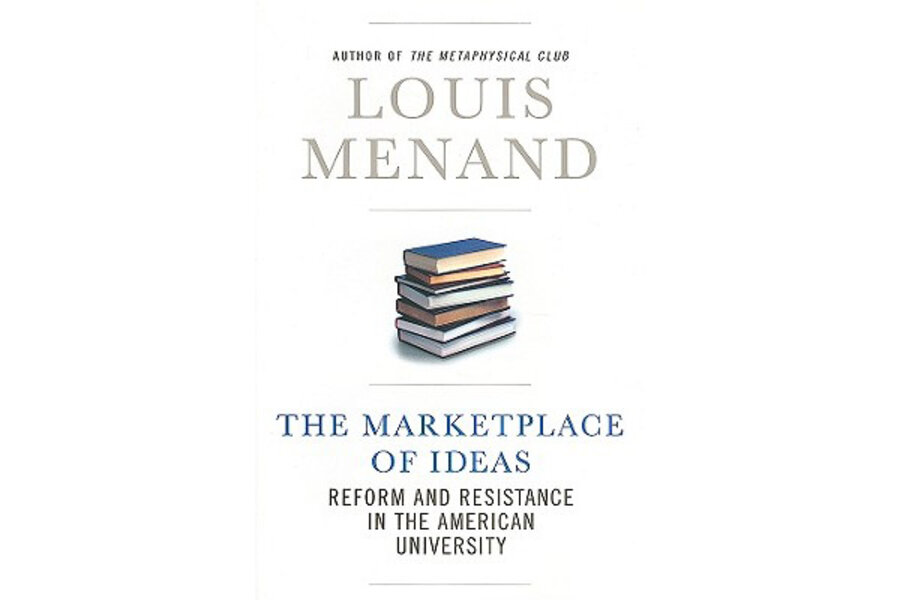The Marketplace of Ideas
Loading...
The structure of the American university has long been a subject of contention, and now is no exception, especially given the current economic climate. Last year, Mark Taylor called for an end to tenure and traditional disciplines in The New York Times op-ed, “End of the University as We Know It,” and William Pannapacker’s column, “Graduate School in the Humanities: Just Don’t Go,” was among the most viewed links on the Chronicle of Higher Education’s website.
If the system looks broken – not just to academics or those fighting the culture wars, but to anyone invested in the idea of a liberal arts education – then fixing it requires an understanding of how the American university came to be in its current state.
This emphasis on historical perspective as a first step to reform distinguishes Louis Menand’s The Marketplace of Ideas: Reform and Resistance in the American University. Located somewhere between Gerald Graff’s “Professing Literature,” which takes the history of literary studies as its focus, and more polemical calls for reform like Taylor’s, Menand approaches his subject by identifying four widespread problems in academia, tracing them back to their roots, and offering ways to move beyond them.
These include the trend of “interdisciplinarity,” the ubiquitous center-left politics of faculty, the identity crisis of the humanities, and the all-too-contentious question of what should constitute a general education program. (Menand was on the committee that recently revamped the curriculum at Harvard University and the book is dedicated to his fellow members.) In excavating the origins of these trends, Menand – whose discipline is English, but who won a 2002 Pulitzer Prize for “The Metaphysical Club,” his outstanding intellectual history of modern America following the Civil War – shows how slippery knowledge and its production can be.
“[F]ew institutions are so conservative as the universities about their own affairs while their members are so liberal about the affairs of others,” Clark Kerr, a chancellor of the University of California, noted in the early ’60s. Menand’s reference to Kerr is a keynote for his study, which shows a keen eye for the paradoxes of university life. The debates on general education and the snail’s-pace process of redesigning it, Menand observes, have “been compared to a play by Samuel Beckett, but the comparison is inapt. Beckett’s plays are short.” Instead, Menand’s analogy is to psychoanalysis: “interminable, repetitive, and inconclusive.” Along the same vein, he notes the circular logic of great books programs (we read them because they’re great and they’re great because we read them).
Menand is renowned as a writer with a cool tone and a keen wit (witness his description of Sputnik as having “the size and lethal potential of a beach ball”). These qualities, and the book’s humanitarian yet practical underpinnings, make it a compelling read.
The history he relates is absorbing, too, serving as a reminder that academia has been an arena interwoven with political agendas and anxieties since the Civil War. General education, for instance, was conceived of during the two World Wars, spurred by a perceived need for cultural unification and civic education among American youth. Columbia’s first general education course, titled “War Aims,” was created at the request of the Army for the Student Army Training Corps, a forerunner of ROTC. A humanities component was adopted later, prompted by the xenophobia of one professor whose anxiety about the increasing enrollment of Jewish immigrants led him to propose a required class in “great Anglo-Saxon writers.”
Recounting the circumstances that led Harvard’s president, Charles Eliot, to establish a liberal arts degree as a prerequisite for professional degrees like law or medicine, Menand calls into question this divide that has become naturalized in higher education. Increased mixing of theoretical knowledge with practical application would serve both students and faculty well, he suggests, something many liberal arts professors have shied away from, much to the detriment of their own programs. The percentage of students pursuing degrees in math has fallen by about half since 1971, and the same is true for English.
Another striking statistic is the fact that 47 percent of college teaching is done by part-time faculty – though “part time” is a misnomer, since they often carry a full-time load – who are paid a fraction of a tenure-track salary and nowhere near a living wage. By explaining the conditions (unlikely to reverse) that have sent the academic marketplace into a long decline, Menand exposes the illogic of the current system, which has produced a glut of overtrained, underemployed PhDs. Menand rightly recognizes this as a species of institutionalized exploitation, only the first on a list of university practices in need of deep reform.
Elizabeth Toohey is an English professor at Principia College in Elsah, Ill., where she specializes in postwar American culture.






